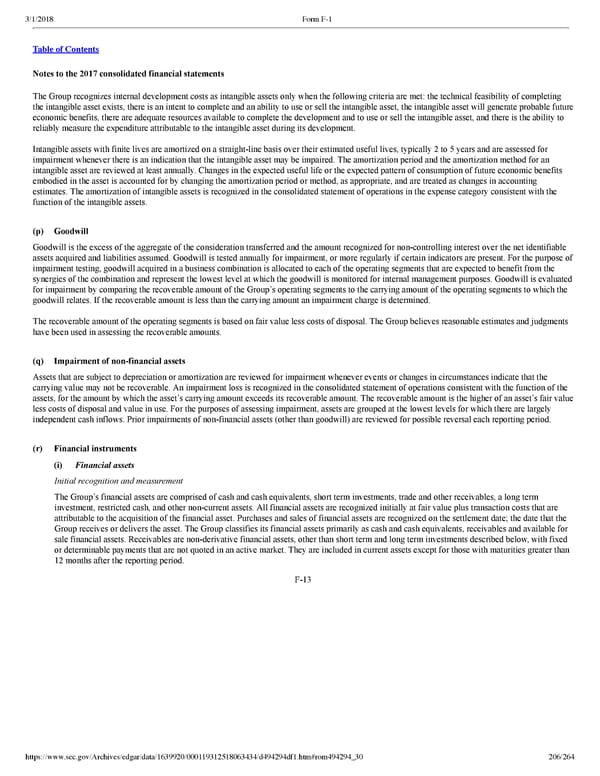206/264 Notes to the 2017 consolidated financial statements The Group recognizes internal development costs as intangible assets only when the following criteria are met: the technical feasibility of completing the intangible asset exists, there is an intent to complete and an ability to use or sell the intangible asset, the intangible asset will generate probable future economic benefits, there are adequate resources available to complete the development and to use or sell the intangible asset, and there is the ability to reliably measure the expenditure attributable to the intangible asset during its development. Intangible assets with finite lives are amortized on a straightline basis over their estimated useful lives, typically 2 to 5 years and are assessed for impairment whenever there is an indication that the intangible asset may be impaired. The amortization period and the amortization method for an intangible asset are reviewed at least annually. Changes in the expected useful life or the expected pattern of consumption of future economic benefits embodied in the asset is accounted for by changing the amortization period or method, as appropriate, and are treated as changes in accounting estimates. The amortization of intangible assets is recognized in the consolidated statement of operations in the expense category consistent with the function of the intangible assets. (p) Goodwill Goodwill is the excess of the aggregate of the consideration transferred and the amount recognized for noncontrolling interest over the net identifiable assets acquired and liabilities assumed. Goodwill is tested annually for impairment, or more regularly if certain indicators are present. For the purpose of impairment testing, goodwill acquired in a business combination is allocated to each of the operating segments that are expected to benefit from the synergies of the combination and represent the lowest level at which the goodwill is monitored for internal management purposes. Goodwill is evaluated for impairment by comparing the recoverable amount of the Group’s operating segments to the carrying amount of the operating segments to which the goodwill relates. If the recoverable amount is less than the carrying amount an impairment charge is determined. The recoverable amount of the operating segments is based on fair value less costs of disposal. The Group believes reasonable estimates and judgments have been used in assessing the recoverable amounts. (q) Impairment of nonfinancial assets Assets that are subject to depreciation or amortization are reviewed for impairment whenever events or changes in circumstances indicate that the carrying value may not be recoverable. An impairment loss is recognized in the consolidated statement of operations consistent with the function of the assets, for the amount by which the asset’s carrying amount exceeds its recoverable amount. The recoverable amount is the higher of an asset’s fair value less costs of disposal and value in use. For the purposes of assessing impairment, assets are grouped at the lowest levels for which there are largely independent cash inflows. Prior impairments of nonfinancial assets (other than goodwill) are reviewed for possible reversal each reporting period. (r) Financial instruments (i) Financial assets Initial recognition and measurement The Group’s financial assets are comprised of cash and cash equivalents, short term investments, trade and other receivables, a long term investment, restricted cash, and other noncurrent assets. All financial assets are recognized initially at fair value plus transaction costs that are attributable to the acquisition of the financial asset. Purchases and sales of financial assets are recognized on the settlement date; the date that the Group receives or delivers the asset. The Group classifies its financial assets primarily as cash and cash equivalents, receivables and available for sale financial assets. Receivables are nonderivative financial assets, other than short term and long term investments described below, with fixed or determinable payments that are not quoted in an active market. They are included in current assets except for those with maturities greater than 12 months after the reporting period. F13
 Spotify F1 | Interactive Prospectus Page 205 Page 207
Spotify F1 | Interactive Prospectus Page 205 Page 207